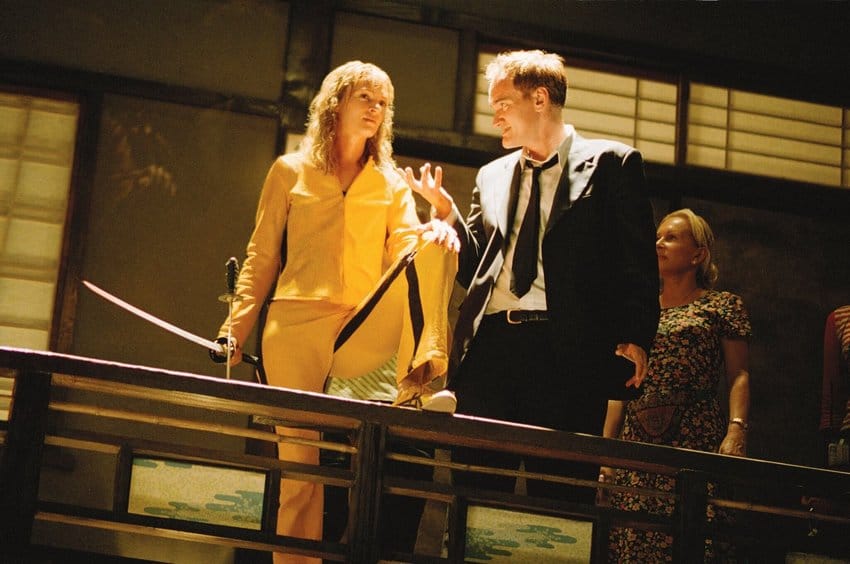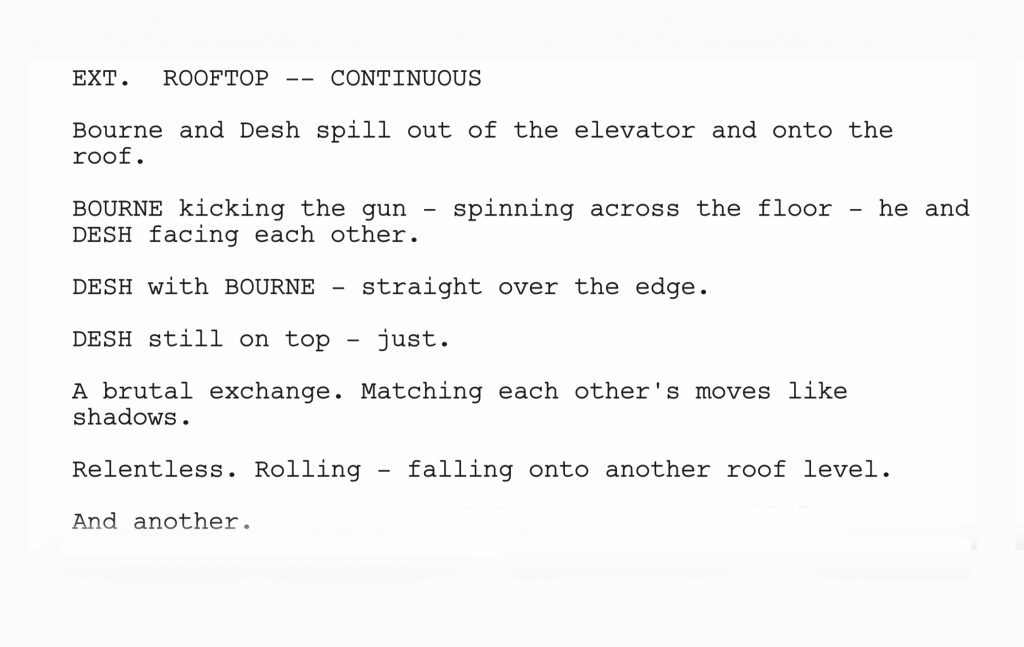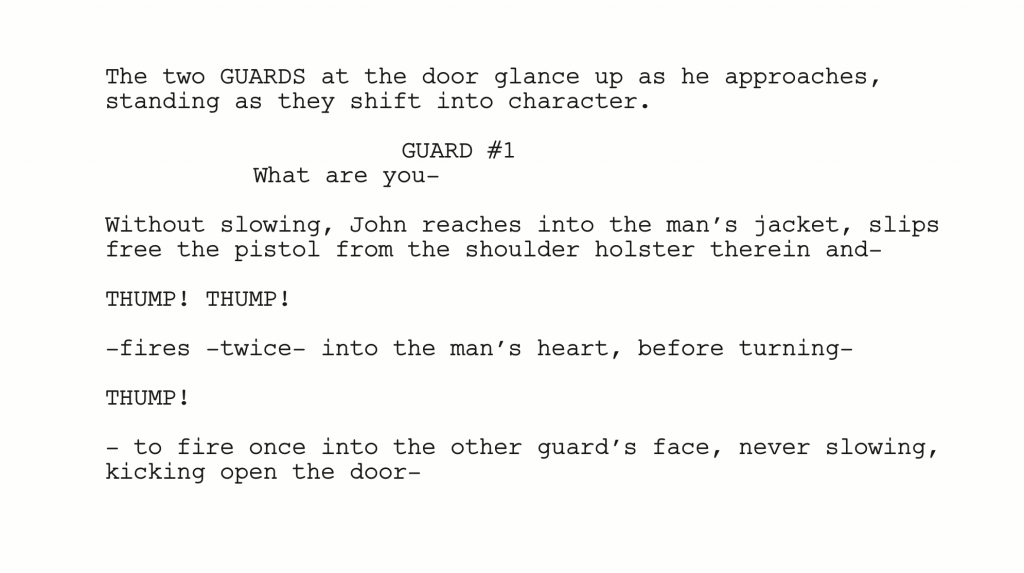How to Write a Fight Scene in a Script

How to write a fight scene in a script.
Writing fight scenes can be tricky for many screenwriters. How exactly do you lay out a fight scene on the page? Do you describe every blow and gunshot? Or do you leave most of it to the director? And if so, how much?
We’ll be answering all these questions and more in this post. And, along with a ton of fight scene writing examples, show you the five pro techniques every writer should use to create a kickass fight scene.
So let’s dive on in.
1. How to write a fight scene in a script: switch between the macro and micro
The most common question we get on how to write a fight scene is, How detailed does it need to be?
Let’s start by taking a look at both extremes:
Example #1
Jonah stumbles into the clearing to find himself face to face with Max. They fight to the death and Jonah wins.
Or…
Example #2
Jonah stumbles into the clearing to find himself face to face with Max.Max immediately strikes the side of Jonah’s neck with all his fingers held straight and tightly together. Jonah responds by using the heel of his palm to strike up under Max’s nose. He throws the whole weight of his body into the move causing Max to cry out in pain as his nasal bones CRACK.But Max rallies and brings up his knee and swiftly turns his hip over, snapping his right leg outwards from the knee to deliver a strike to Jonah’s head with the ball of his foot…
And so on.
Neither of these two styles are recommended.
Example #1 tells us what happens on a macro-level, but nothing about what we’re actually supposed to see on screen.
It’s all summation and no emotion.
All responsibility is handed over to the director and stunt coordinator, while the reader is left to imagine what happened themselves.
Example #2, on the other hand, tells us everything that happens on a micro-level and too much about what we’re seeing on screen.
Nothing is left to the director, stunt coordinator or reader’s imagination.
Switch between the macro and micro.
When writing fight scenes, the trick is to combine both examples and describe the fight scene on a macro as well as a micro-level.
The macro-level.
Describe a similar series of blows, parries, gunshots, sword thrusts, etc. over a short period of time.
Think of this as a general overview that gives the reader a strong sense of the style of the fight taking place, but without describing every little detail.
For example:
For example:
Jonah and Max trade blows at a furious speed.
The micro-level.
Follow this with a micro-level description of the culmination of these blows when something significant happens that moves the scene in a new direction.
For example:
Jonah and Max trade blows at a furious speed before —Jonah uses the heel of his palm to strike up under Max’s nose. Max’s nasal bones CRACK as he collapses to the ground. Jonah stands over him.
Here’s some fight scene description from The Bourne Ultimatum that perfectly illustrates this technique:

Note how we constantly switch between the macro and micro-levels here. We get a general sense of what’s happening followed by a specific detail whenever something important happens.
Macro:
• “The two men tiring now”
• “Bourne has the upper hand now. Desh’s reaction’s slowing”
• “No longer the match he was”
• “He’s finished. Bourne’s won”
Micro:
• “Desh grabbing for the bag. The pills. Bourne kicking them away”
• “Bourne drags him to the ground”
• “Desh — shivering — convulsing”
• “In the struggle, Bourne strangles Desh”
Here’s another fight scene example that demonstrates this technique from the Lone Survivor screenplay:

Again, we go from a general overview:
“Crawling, shooting and covering…”
To a specific event that’s worth highlighting:
“Axe shot through the left shoulder. Ignoring it he keeps firing.”
Using each sentence as either a macro or a micro viewpoint, switching between both—macro > micro > macro > micro—can be a very effective way of communicating the style and flow of a fight scene.
Which brings us to technique #2…
2. How to write a fight scene in a script: use one line per camera shot.
This technique can be used while writing all kinds of description, but it’s particularly useful when writing fight scenes:
Become close friends with your return key.
Tab down to the next line every time the action switches perspective so that each line becomes a camera shot.
For example, in the Lone Survivor example above, we have three implied camera shots:
• Shot #1: A wide-angle as the four SEALs make their way to the side of the ambush
• Shot #2: A reverse angle on the Taliban
• Shot #2: A reverse angle on the Taliban
• Shot #3: A closeup on Axe getting hit in the shoulder
Here’s another fight scene description that perfectly illustrates this technique, this time from Kill Bill:

Here we see six implied camera angles as we shift between Vernita, the Bride and the bullets.
And all without actually writing ANGLE ON, CLOSE ON, REVERSE ANGLE, etc.
We don’t need to have the camera shots spelled out because they’re put in our mind by the “one line, one shot” writing style.
There’s nothing stopping you from writing in the actual camera angles but, overall, omitting them makes for a more free-flowing reading experience. (Or at least, using them sparingly.)
A word on ellipses, all caps and white space.
Note too how this Kill Bill fight scene description employs ALL CAPS to highlight sound effects and the big moments. And how ellipses are used to draw the eye down the page. Em dashes (- -) are a great alternative option.
As each line represents a new camera shot, the effect is to leave a lot of white space on the page—all of which makes for an easier reading experience that suppresses the urge to skim.
The alternative Kill Bill fight scene description would look something like this:
Vernita fires a gun from inside the cereal box at The Bride. The bullet explodes out of the cardboard box, and hits the coffee mug directly in front of The Bride, blowing it to smithereens.The Bride throws herself on the floor. Vernita pulls the gun out of the cereal box and fires again. The bullet hits the floor of the tiny kitchen. The Bride moves under the kitchen table, then using her back, lifts the table off the ground, ramming it straight into Vernita, pinning her flat up against the table top, and the kitchen counter.
Not quite as easy to read… Therefore keep these points in mind when writing fight scenes:
• Keep your sentences and paragraphs short
• Use emotional verbs and adjectives
• Employ all caps sporadically to draw attention to exciting moments
• Hit your return key every time you want to imply a new camera shot
3. How to write a fight scene in a screenplay: set the stage.
Rather than writing fight scenes by just stating, say, “INT. WAREHOUSE – NIGHT” and barreling into the action, it can be useful to take a step back and consider the location.
What kind of space does your fight scene take place in?
• How might it affect the ensuing fight?
• Is it indoors or outdoors?
• Open or confined?
• Are there bystanders around or not?
• Is this a mundane location or an unusual one?
And so on.
Spend some time establishing the location in your mind so you can then translate this into the script and fight scene itself.
• Ask yourself how the characters might exploit the location?
• Where can they hide?
• What decoys can they employ?
• What objects lying around can they use as weapons?
A fight that takes place in a hotel bathroom is obviously going to have an entirely different feel and set of possibilities than one that weaves in and around the letters of the Hollywood sign.
Describing a fight scene is easier if you’re intimately familiar with the location.
Take a pad and pencil and physically sketch out the characters’ fighting space on paper. Look up pictures of it online.
Do you know anyone who’s more familiar with the location than you are? If so, talk to them.
All of this will help you visualize the space and how the characters might interact with it.
Sketching out, or at least visualizing, the location will help give the fight scene a greater sense of realism when it comes to actually write it.
Or, better yet, visit the kind of location you have in mind
If your fight scene takes place in a warehouse, the woods, or the back of a limousine, actually go to the location and get inspired.
Just being in the physical space will make it easier to put yourself in your characters’ shoes as they fight.
How hard or easy is it to fight there? How is the space an asset or a hindrance to one or all of the characters involved?
In sum, choose your location carefully. Understand it and make sure you fully exploit all of its possibilities.
4. How to write a fight scene: read fight scenes in scripts.
One of the best ways to learn how to write a fight scene in a script is by seeing how the pros do it.
Here are the links to five screenplays to get you started—all containing a variety of styles of combat—that will aid your own fight scene description.
Fight scene writing examples.
The Bourne Ultimatum
written by Tony Gilroy, George Nolfi and Scott Z. Burns

The Dark Knight
written by Jonathan Nolan, Christopher Nolan and David S. Goyer

Deadpool
written by Rhett Reese and Paul Wernick

John Wick (Original script title “Scorn”)
written by Derek Kolstad

Lone Survivor
written by Peter Berg, Marcus Luttrell, Patrick Robinson

The Matrix
written by Lilly Wachowski and Lana Wachowski

There must be a purpose behind writing fight scenes.
A common fault of fight scenes in spec scripts is that they serve no particular purpose.
Things get shot up, thugs get beaten up for a couple of pages and that’s that. Without any story or character development.
It’s important to remember that, as movie-goers, we’re not nearly as interested in every cool martial arts move or double-tap to a bad guy’s head, as we are about the stakes involved in the fight scene.
As you read the above scripts, and before writing any fight scene, keep these questions in mind:
• What’s at stake for the protagonist?
• What is he/she fighting for?
• How does this scene move the story forward?
• How does this scene reveal character?
Don’t make the same mistake many spec writers make of writing fight scenes just in an attempt to excite the reader. It won’t.
Unless they’re emotionally connected to why the fight’s happening in the first place.
5. How to write a fight scene in a script: research the fighting style.
Often the fight scene description in a script feels unrealistic because the writer doesn’t know much about the type of fight they’re describing.
It’s fairly quick and easy to get familiar with a particular fighting style or the rudiments of handguns and is well worth it if you want to create a more realistic fight.
Here are a few ideas:
• Read blog posts
• Watch YouTube videos
• Attend a demo/contest
• Talk to experts
• Take classes yourself
If you’re writing, say, a boxing movie, we’re not suggesting you have to describe every move in minute detail.
But you should be familiar enough with the rudiments of the sport that you can add some color to your fighting scene description with a few evocative “hooks,” “slips” and “rolls.”
How to write a fight scene in a screenplay: conclusion.
Our last piece of advice when writing fight scenes is this:
You’re not writing just any old fight scene that’s identical to a billion others out there that we’ve already seen. This is your fight scene that’s original and specific to your script.
Always ask yourself, What sets this fight apart from the rest? What’s different about its location, style, tone, stakes, etc.?
For example, the first fight scene in Kill Bill between the Bride and Vernita is memorable and special not really because of all the cool moves they pull off.
It’s memorable because of stakes surrounding the Bride’s mission and all the tension Tarantino builds before she even starts fighting.
Also, when writing fight scenes, don’t forget that they should follow many of the same rules as when writing “normal” scenes: a 3-act structure, reversals and so on.



Comments
Post a Comment